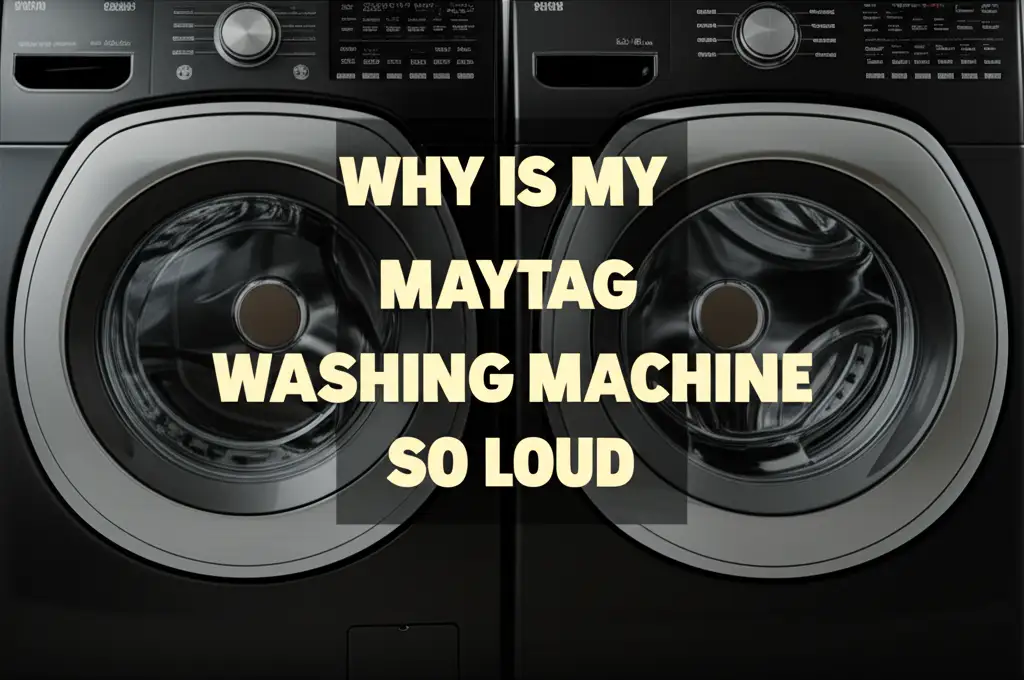· Katria Melrose · Appliance Troubleshooting · 21 min read
Why Is My Maytag Washing Machine So Loud

Why Is My Maytag Washing Machine So Loud? A Comprehensive Guide
A quiet home environment feels comforting. Then, suddenly, a thunderous roar or a persistent clunk comes from your laundry room. Your Maytag washing machine, once a reliable workhorse, has turned into a noisy disruptor. This sudden shift can be quite alarming and frustrating. You might wonder if your machine is broken or if it is a simple fix.
I know the annoyance a loud washing machine brings. It interrupts conversations and can even make you avoid doing laundry. My aim is to help you understand why your Maytag washing machine is so loud. We will explore the common reasons behind these noises. This guide will help you identify the specific sound and its cause. We will also cover practical steps to quiet your noisy Maytag. You will learn to perform basic diagnostics and even some repairs yourself. Get ready to reclaim the peace in your home.
Takeaway
If your Maytag washing machine is loud, here are the key steps to address the issue:
- Identify the type of noise to pinpoint the cause.
- Check for an unbalanced load or an uneven machine.
- Inspect for foreign objects in the drum or pump filter.
- Examine internal components like bearings, belts, and shock absorbers for wear.
- Consider issues with the water pump or motor.
- Perform regular maintenance to prevent future noise problems.
- Consult a professional if DIY solutions do not work.
Your Maytag washing machine makes loud noises due to various issues. These include an unbalanced load, foreign objects in the drum or pump, worn-out bearings, a faulty drive belt, or issues with the motor or water pump. Addressing these common problems often resolves the noise.
Pinpointing the Sounds: What Noise Is Your Maytag Making?
Before you begin troubleshooting, listen closely to your washing machine. The type of sound it makes often tells you what part is causing the issue. Different noises point to different problems. Identifying the specific sound helps narrow down the possibilities. This makes your repair efforts more efficient. Let me walk you through some common Maytag washing machine noises.
Hissing, Whistling, or Squealing Noises
If your machine makes a hissing, whistling, or squealing sound, it often relates to water flow or friction. A hiss might mean a water leak. It could also come from a faulty water inlet valve. Sometimes, a high-pitched squeal indicates a belt issue. The belt could be loose, worn, or misaligned. This noise is typically noticeable during agitation or spin cycles. It suggests a part is rubbing where it should not.
Grinding, Scraping, or Clicking Sounds
Grinding, scraping, or clicking noises are usually more serious. These sounds often suggest something is caught or worn out inside. Foreign objects, like coins or buttons, can cause these sounds. They get stuck in the drum or pump. If no foreign object is present, the noise could mean worn bearings. Bearings support the drum’s rotation. When they fail, the drum wobbles and grinds. You might hear scraping if the outer tub rubs against the inner tub. This happens if the suspension system is failing.
Banging, Thumping, or Clunking Noises
A banging, thumping, or clunking sound is very common. This often happens during the spin cycle. The most frequent cause is an unbalanced load. Heavy items can shift to one side. This makes the drum hit the machine’s sides. Loose components, like counterweights or shock absorbers, also cause these sounds. If the machine is not level, it will rock and bang. Even new machines can make these noises if not set up correctly.
Humming or Buzzing Sounds
A low humming or buzzing sound is usually electrical or motor-related. A slight hum is normal when the motor runs. However, a loud, constant buzz may indicate a problem. It could be the motor struggling. It might also be a faulty water pump trying to move water. Sometimes, a clogged drain pump can cause a loud buzzing noise. The pump works harder to push water through a blockage. This noise is usually consistent throughout a cycle or during specific parts like draining.
Is Your Maytag Washing Machine Unbalanced or Uneven?
One of the most common reasons your Maytag washing machine is so loud is a simple issue: it is unbalanced. This problem often results in loud banging or thumping sounds. An unbalanced machine rocks back and forth violently. This can happen during the wash or spin cycle. It is an easy issue to check and often to fix. I always start here when my own washer gets noisy.
Uneven Load Distribution
An uneven load is the most frequent cause of an unbalanced machine. When you wash heavy items, they can clump together. Items like towels, blankets, or jeans absorb a lot of water. If these items gather on one side of the drum, it throws the machine off balance. The drum tries to spin at high speeds. This imbalance causes it to wobble violently, leading to loud banging noises. Always distribute your laundry evenly inside the washer drum. This is crucial for both top-loader and front-loader machines. If your machine stops mid-cycle and makes noise, check the load first.
To fix an uneven load, pause the washing machine. Open the lid or door. Redistribute the clothes by hand. Make sure items are spread out around the agitator or drum. Close the lid or door and restart the cycle. This simple step often solves the problem instantly. I have found this to be the quickest solution many times.
Machine Not Level
Another common cause for a loud, unbalanced machine is that it is not level. Washing machines have adjustable legs. These legs allow you to make the machine stand flat on the floor. If the machine wobbles, it is not level. A wobbly machine will shake more during operation. This shaking can amplify noises and stress internal components.
To check if your Maytag washing machine is level, gently push on each corner of the top panel. If it rocks, it needs leveling. You can use a spirit level tool. Place it on top of the machine from front to back, then side to side. Adjust the leveling legs until the bubble is centered. Turn the nuts on the legs to raise or lower them. Some machines have self-locking nuts; others require a wrench. Make sure all four feet sit firmly on the floor. Proper leveling prevents excessive vibration and noise.
Worn or Damaged Leveling Legs
Over time, the leveling legs themselves can wear out or become damaged. Rubber feet can degrade or fall off. The threads on the legs can strip. If a leg is broken or cannot be adjusted, the machine will remain uneven. Visually inspect all four legs. Make sure they are intact and firmly attached. Replace any damaged legs to ensure the machine sits level. A stable base is essential for a quiet Maytag washing machine.
Foreign Objects: The Hidden Culprits Making Your Maytag Loud
Sometimes, the culprit behind a loud Maytag washing machine is not a mechanical failure at all. It is something simple: foreign objects. These small items can find their way into places they do not belong. Once inside, they cause a range of disturbing noises. Always check your pockets before washing clothes. This simple habit can save you from a lot of trouble.
Objects in the Washing Machine Drum
Loose items left in pockets are notorious for causing noise. Coins, keys, pens, hairpins, or even small toys can fall out during the wash cycle. They can then get caught between the inner and outer drums. When the drum spins, these objects rattle, scrape, or click against the metal. This creates a very noticeable and irritating sound. The noise often gets louder during agitation and especially during the spin cycle.
To check for objects in the drum, first, unplug your Maytag washing machine. This is a crucial safety step. Then, look inside the drum. Carefully feel around the gaps between the inner and outer tubs. You might need a flashlight. Sometimes, tilting the drum slightly helps. Use a pair of pliers or tweezers to retrieve any objects you find. If you have a front-loader, check the rubber gasket around the door. Small items can get stuck there too. Removing these items can instantly quiet your machine.
Clogged or Blocked Drain Pump Filter
Another common hiding spot for foreign objects is the drain pump filter. This filter catches debris before it enters the drain pump. It prevents damage to the pump. However, if the filter becomes clogged, it can cause the pump to struggle. This struggle often results in a loud humming, buzzing, or grinding noise. Small items like buttons, lint, or even socks can block this filter. The pump tries to force water through the blockage, creating the noise.
Locating the drain pump filter usually involves opening a small panel at the bottom front of your Maytag washing machine. Refer to your owner’s manual for the exact location. Before opening the filter, place a shallow pan or towels underneath. Some water will likely drain out. Twist the filter counter-clockwise to remove it. Clean any debris from the filter and its housing. You might be surprised by what you find. I once found several hair ties and a coin in mine. After cleaning, screw the filter back in tightly. Regular cleaning of this filter is a smart practice. You can learn more about general washing machine filter cleaning to prevent future issues. This is a simple maintenance step that keeps your machine quiet and efficient. For Maytag top-loaders, specifically, there’s a guide on how to clean Maytag washing machine filter top loader no agitator.
Items Stuck in the Drain Hose
Less common, but still possible, are items stuck further down the drain hose. If an object passes the pump filter, it can get lodged in the drain hose. This restricts water flow and puts strain on the pump. The pump will work harder, leading to louder noise. It can also cause slow draining or no draining at all. Checking the drain hose might require disconnecting it from the machine and the standpipe. Always ensure the machine is unplugged before attempting this. Remove any blockages you find. This step is more involved but can be necessary for persistent pump-related noise.
Worn-Out Parts: Addressing Internal Component Noises in Your Maytag
When your Maytag washing machine is consistently loud, even after checking for simple fixes, it often points to worn-out internal components. These parts endure significant stress over years of operation. Eventually, they degrade and cause various grinding, squealing, or rattling noises. Replacing these parts can extend the life of your machine. This often saves you from needing a new one.
Drum Bearings
One of the most common causes of loud grinding or roaring noises, especially during the spin cycle, is worn drum bearings. Bearings allow the inner tub to spin smoothly. Over time, water can seep past the seal, causing the bearings to rust and seize. When they fail, the drum will wobble excessively. You will hear a loud metal-on-metal grinding sound. To check, open the washer door. Grab the inner tub and try to move it up and down. If it wiggles significantly and makes noise, the bearings are likely bad.
Replacing drum bearings is a complex repair. It often requires disassembling much of the washing machine. You might need special tools. If you are comfortable with such tasks, a DIY washing machine repair guide can offer broader insights. However, for bearings, it can be a challenging job for most homeowners. Many people choose to hire a professional for this repair. The cost of parts and labor can sometimes approach the cost of a new machine, especially for older models.
Shock Absorbers or Suspension Rods
Washing machines use shock absorbers or suspension rods to dampen the tub’s movement. These components prevent the tub from hitting the machine’s frame during cycles. If they wear out, the tub will bounce around excessively. This leads to loud banging or thumping noises, particularly during the spin cycle. The machine might also vibrate more than usual. You can often see these rods or absorbers by opening the top panel of your Maytag washer.
To check them, look for signs of oil leaks or visible damage on shock absorbers. For suspension rods, try pushing down on the tub and releasing it. A healthy suspension system will allow the tub to bounce once or twice before settling. If it bounces multiple times or hits the frame, the parts are weak. Replacing shock absorbers or suspension rods is generally easier than replacing bearings. It usually involves disconnecting them from the tub and frame and installing new ones. This is a repair many homeowners can perform with basic tools.
Drive Belt
Many Maytag washing machines use a drive belt to transfer power from the motor to the transmission or drum. A worn, stretched, or frayed drive belt can cause a squealing or burning rubber smell. It might also lead to the drum not spinning properly. The belt can slip, creating a high-pitched noise. It can also snap, causing the drum to stop completely.
To inspect the drive belt, you usually need to remove the back panel of the washer. Unplug the machine first for safety. Visually check the belt for cracks, fraying, or looseness. If it seems stretched, it needs replacement. The belt should be taut but not overly tight. Replacing a drive belt is a relatively straightforward repair. You simply loop the new belt around the motor pulley and the transmission or drum pulley. Ensure it is seated correctly.
Motor Coupler (Direct Drive Machines)
Some older Maytag washing machines use a direct-drive system instead of a belt. These machines have a motor coupler. This small rubber and plastic component connects the motor directly to the transmission. If the motor coupler fails, you might hear a loud grinding or spinning noise. The motor will spin, but the agitator or drum will not move.
To check the motor coupler, you usually need to tilt the machine back or lay it on its side. Remove the motor to access the coupler. Look for broken plastic pieces or rubber debris. Replacing the motor coupler is a common repair for direct-drive Maytag machines. It is usually an affordable part. The repair involves removing the motor and replacing the damaged coupler halves. This task is manageable for most DIY enthusiasts.
Addressing Issues with Your Maytag’s Water Pump
The water pump plays a vital role in your Maytag washing machine. It removes water from the tub during the drain cycle. If the pump has problems, it can become very loud. A failing or obstructed pump often produces distinct noises. These noises can range from grinding to buzzing. Understanding these issues helps you fix your loud Maytag washing machine.
Clogged Drain Pump
A clogged drain pump is a very common cause of loud buzzing or grinding noises. The pump filter, which I mentioned earlier, traps debris. However, if debris bypasses the filter or the filter itself is full, the main pump can get clogged. Small items like coins, lint, buttons, or even small pieces of fabric can enter the pump’s impeller. The impeller is the part that spins to push water out. When it encounters an obstruction, it struggles. This struggle creates a loud buzzing or grinding sound. The machine might also fail to drain properly or drain very slowly.
To address a clogged drain pump, you must first access it. On most Maytag front-loaders, the pump and filter are behind a small panel at the bottom front. For top-loaders, you might need to tilt the machine back or remove a lower panel. Always unplug the washing machine before you start. Place towels or a shallow pan underneath, as water will likely come out. Remove the pump filter and clean it thoroughly. Also, carefully inspect the impeller area inside the pump housing for any lodged items. Remove anything you find. This often resolves the noise and restores proper draining. Sometimes, a stubborn clog means you have to disconnect the drain hose or pump itself to clear it.
Worn or Damaged Water Pump
If there are no clogs, the water pump itself might be worn out or damaged. Over time, the internal components of the pump can degrade. The motor within the pump can wear down. Bearings in the pump can fail. This leads to a persistent grinding, rattling, or high-pitched whining noise during the drain cycle. You might also notice water not draining completely or the pump running continuously. A damaged impeller, even without a clog, can also cause noise. The blades might be chipped or broken.
Replacing a worn-out water pump is a more involved repair. It requires disconnecting water hoses and electrical connections. You will need to unbolt the old pump and install a new one. While a new pump can be expensive, it is often more cost-effective than replacing the entire washing machine. This repair is manageable for a DIY enthusiast with some basic tools. Ensure you get the correct pump model for your specific Maytag washing machine. A Maytag washing machine that is leaking water from underneath could also be related to a failing pump. This indicates damage to the pump housing or seals.
Issues with Water Inlet Valve
While less common for direct loudness, a faulty water inlet valve can sometimes contribute to noise. This valve controls the flow of water into the washer. If it is partially clogged or failing, it might make a distinct hissing or whistling noise when the machine fills with water. The valve might also struggle to open fully. This restricts water flow and could indirectly strain the pump if the machine tries to compensate. Cleaning the water inlet valve screens can sometimes resolve this. You can find more information on how to clean water inlet valve on Maytag washing machine for specific instructions. Proper water flow is important for the overall efficiency and quiet operation of your machine.
Motor and Transmission Troubles in Your Maytag Washer
When your Maytag washing machine is very loud, the motor or transmission might be the cause. These are central to the machine’s operation. Problems with these parts often result in distinct, serious noises. These noises can include humming, grinding, or loud thumping. Addressing these issues often requires more advanced repair skills.
Failing Motor
The motor is the heart of your Maytag washing machine. It drives the agitator and spins the drum. A failing motor can produce a loud humming, buzzing, or grinding noise. This noise might get louder during different cycles, especially during agitation or spin. If the motor bearings are worn, they will create a loud whirring or grinding sound. You might also notice a burning smell. This smell indicates the motor is overheating or experiencing friction. Sometimes, a weak motor will struggle to start or complete cycles.
Diagnosing a failing motor often requires a multimeter to test its electrical components. A motor professional can help confirm this. Replacing the motor is a significant repair. It involves disconnecting electrical wires and mounting bolts. It is a repair that can be done by a skilled DIYer. However, many people opt for professional help given the complexity and cost of the part. If your Maytag washing machine is making these sounds, it is crucial to address them quickly. Ignoring a failing motor can lead to complete machine breakdown.
Transmission Issues
The transmission system in a top-load washer converts the motor’s rotational energy into the agitator’s back-and-forth motion and the drum’s spinning motion. In front-loaders, a direct drive or belt system replaces the traditional transmission. If your Maytag top-loader has a grinding, clunking, or chattering noise during agitation or spin, the transmission might be failing. This is a less common issue for newer machines but can occur in older models. The internal gears within the transmission can wear out. This wear creates friction and noise. You might also notice the agitator not moving as effectively.
Transmission repair is one of the most complex washing machine repairs. It usually involves removing the entire transmission assembly. This part is typically located under the wash tub. Replacing a transmission is costly and labor-intensive. In many cases, if the transmission fails, it might be more economical to replace the entire washing machine. However, if you are an experienced DIYer, you might consider this. For information on removing parts like control panels to access internal components, you might find a guide on how to remove Maytag washing machine control panel useful. This can help with initial access and diagnostic steps.
Motor Mounts
Sometimes, the motor itself is fine, but its mounting system is not. Motor mounts are rubber or plastic components that secure the motor to the washing machine’s frame. They also absorb some of the motor’s vibrations. If these mounts become loose, cracked, or worn, the motor will vibrate excessively. This causes a loud rattling or thumping noise. The sound often varies with the motor’s speed.
To check motor mounts, you usually need to access the motor by removing a back or bottom panel. Inspect the mounts for any visible damage. Ensure they are tight and holding the motor securely. Replacing motor mounts is a relatively simple and inexpensive repair. It involves unbolting the old mounts and installing new ones. This small fix can significantly reduce noise and vibration. It is an easy DIY task that can save you from more complex motor issues down the line.
Proactive Maintenance to Prevent Your Maytag Washing Machine from Being Loud
Preventing your Maytag washing machine from becoming loud is often easier than fixing it once it starts making noise. Regular maintenance plays a crucial role. Just like a car needs oil changes, your washing machine benefits from routine care. These simple steps can extend its lifespan. They also ensure it runs quietly and efficiently. I find that a little maintenance goes a long way.
Regular Cleaning of the Washing Machine
One of the best ways to keep your Maytag washer quiet is to keep it clean. Mineral deposits, detergent residue, and mold can build up inside. This buildup can affect the machine’s balance and the performance of its parts. Mold and grime can even cause unpleasant odors. More importantly, they can create friction points. For instance, residue can build on the drum, leading to imbalance over time.
You should run a cleaning cycle on your Maytag washing machine regularly. Many modern Maytag machines have a “Clean Washer” cycle. If yours does not, you can run an empty hot water cycle. Add a cup of white vinegar or a specialized washing machine cleaner. This helps break down soap scum and mineral deposits. For front-loader machines, pay special attention to the rubber gasket around the door. This area can trap water, mold, and small items. Wiping it down after each use and cleaning it thoroughly once a month prevents many issues. For detailed steps, consider reading about how to clean Maytag washing machine front loader. General tips on how to clean washing machine with vinegar are also very helpful.
Inspecting Hoses and Connections
Periodically check the hoses and connections on your Maytag washing machine. Over time, hoses can become stiff, cracked, or loose. A loose fill hose connection can cause a vibrating or rattling noise. A partially kinked drain hose can strain the pump, making it louder. Look for any signs of wear or leaks.
Ensure all hoses are securely attached. Make sure they are not kinked. Also, check the inlet screens on the water supply hoses. These screens prevent debris from entering the machine. If clogged, they can restrict water flow, leading to noise from the water inlet valve. Cleaning these screens is a simple task that can prevent potential issues. This prevents strain on components and keeps water flowing freely.
Proper Loading Practices
As discussed, an unbalanced load is a major cause of noise. Proper loading is a maintenance habit that prevents this. Avoid overloading your Maytag washing machine. Overloading stresses the motor, bearings, and suspension system. It also prevents clothes from getting clean. This can cause the machine to struggle and become very loud.
Distribute laundry evenly around the agitator or drum. For top-loaders, place items loosely around the central agitator. For front-loaders, simply avoid stuffing the drum too full. Leave enough space for clothes to tumble freely. Mix large, heavy items with smaller, lighter ones. This helps balance the load. If you wash only one or two heavy items, add a few towels to balance the load. This simple practice significantly reduces noise and wear on your machine.
Annual Professional Check-Up
Even with regular
- Maytag Washer Noise
- Loud Washing Machine
- Appliance Repair
- Washing Machine Troubleshooting
- Maytag Appliance
- DIY Appliance Repair





